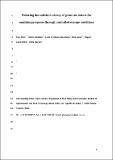Por favor, use este identificador para citar o enlazar a este item:
http://hdl.handle.net/10261/156826COMPARTIR / EXPORTAR:
 SHARE SHARE
 CORE
BASE CORE
BASE
|
|
| Visualizar otros formatos: MARC | Dublin Core | RDF | ORE | MODS | METS | DIDL | DATACITE | |

| Título: | Fostering the antiviral activity of green tea extract for sanitizing purposes through controlled storage conditions |
Autor: | Falcó, Irene CSIC ORCID; Randazzo, Walter CSIC ORCID; Gómez-Mascaraque, Laura G. CSIC ORCID; Aznar, Rosa CSIC ORCID; López-Rubio, Amparo CSIC ORCID ; Sánchez Moragas, Gloria CSIC ORCID | Palabras clave: | Enteric viruses Natural compounds Food-contact surfaces |
Fecha de publicación: | 1-sep-2017 | Editor: | Elsevier | Citación: | Food Control 84: 485-492 (2018) | Resumen: | Food-contact surfaces is considered an important vehicle for the indirect transmission of foodborne viral diseases with enteric viruses, especially human norovirus (HuNoV) and hepatitis A virus (HAV). The aim of the present study was to evaluate the antiviral activity of green tea extract (GTE) at room temperature as a function of pH and storage time and to relate it with changes in composition as a consequence of degradation and epimerization reactions in the storage conditions. The obtained results revealed that freshly prepared GTE was very effective in inactivating murine norovirus (MNV) and HAV at neutral and alkaline pH but was ineffective at pH 5.5. Additionally, storage of the solutions for 24 h at various pH conditions significantly increased their antiviral activity. The reduction in MNV and HAV infectivity was related to the formation of catechin derivatives during storage, as demonstrated by HPLC/MS analysis. In addition, the GTE prepared under the optimal conditions (24 h storage and pH 7.2) was applied at a concentration of 5 mg/mL for only 15 min on stainless steel and glass surfaces for sanitizing purposes, showing a reduction of more than 1.5 log of MNV and HAV infectivity. These findings indicate that GTE can be used as a natural disinfectant for decontamination of food contact surfaces, thus preventing the indirect transfer of enteric viruses to food or persons. | Versión del editor: | https://doi.org/10.1016/j.foodcont.2017.08.037 | URI: | http://hdl.handle.net/10261/156826 | DOI: | 10.1016/j.foodcont.2017.08.037 | ISSN: | 0956-7135 |
| Aparece en las colecciones: | (IATA) Artículos |
Ficheros en este ítem:
| Fichero | Descripción | Tamaño | Formato | |
|---|---|---|---|---|
| Fod Control-2017-Falco.pdf | Artículo principal | 455,45 kB | Adobe PDF |  Visualizar/Abrir |
CORE Recommender
SCOPUSTM
Citations
40
checked on 11-abr-2024
WEB OF SCIENCETM
Citations
39
checked on 28-feb-2024
Page view(s)
381
checked on 23-abr-2024
Download(s)
439
checked on 23-abr-2024
Google ScholarTM
Check
Altmetric
Altmetric
Este item está licenciado bajo una Licencia Creative Commons

